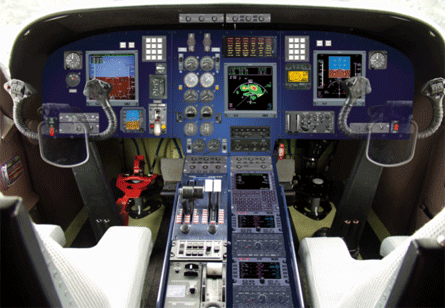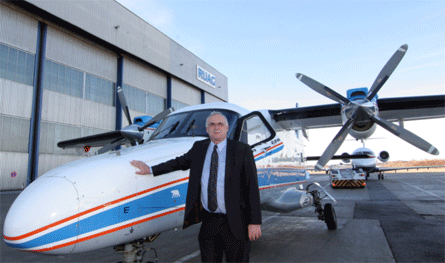When Ruag took over support of the Dornier 228 in 2003, few imagined it would lead to a resumption of its production
There were few people in the aerospace industry who did not believe that the collapse of Fairchild Dornier in 2002 signalled the death knell for civil aircraft production in Bavaria, southern Germany.
Ambitious plans to assemble the 728Jet family of large regional airliners at Oberpfaffenhofen were effectively dead by the end of that year, although sporadic attempts to revive the programme continued until mid-2004, while AvCraft Aerospace's hopes for achieving a sustainable resumption in deliveries of the smaller 328Jet were finally snuffed out in early 2005.
 |
|---|
©RuagThe glass cockpit will feature Rockwell Collins digital avionics and Universal displays |
Four years ago, no-one would have been more dismissive of prospects for a resumption of civil aircraft assembly at the historic Oberpfaffenhofen site than Ruag Aerospace Services managing director Wolfgang Neumann. Switzerland-based Ruag acquired some of Fairchild Dornier's assets in 2003 to create its Aerospace Structures and Aerospace Services units at Oberpfaffenhofen.
As part of the deal, the services unit took over the Dornier 228 worldwide support operation and associated intellectual property, including design drawings and production tooling.
"When Ruag took over the 228 programme there was no intention to relaunch the 228," says Neumann, who joined Dornier in 1985. "The intention was to make the support business for the 180 to 200 aircraft flying around the world."
The last 228 to be built in Germany rolled off the production line in 1995, and during the Fairchild Dornier era the 228 support business had been neglected. Following the Ruag takeover, however, it became a core business for the company.
The seemingly outlandish idea of resuming production of the popular turboprop was first floated during a 228 operators' conference in September 2004.
"The operators were asking for additional aircraft," says Neumann. "We then saw that the used aircraft market was empty because aircraft were flying again. We looked into the market and we found out there was demand in the commuter market, as well as for special missions."
It was not until January 2006 that Neumann approached the Swiss parent company with a formal proposal to put the 19-passenger 228 back into production and offer it in the regional airline, special mission and military tactical transport markets.
 |
|---|
©RuagThe potential interest in a revived 228 suprised Ruag's nmanaging director Wolfgang Neumann |
LIMITED DESIGN CHANGES
"We had to convince them thatin terms of strategy we could make something out of that," he says. Ruag's board gave the go-ahead to the plan in October 2007 and Neumann says the production restart is costing "less than c10 million [$15.5 million]", thanks to the limited number of design changes.
"For us an important point from which to start the programme is that we do not want to touch the type certificate - this would have created a problem for the business plan," says Neumann. "We did the business plan very, very conservatively as a Swiss/German company. We have looked at the market for 10 years and our business plan is looking for 60-80 aircraft."
Neumann says Ruag needs to sell "less than half" of that number to break even. "After the two-year start-up phase we have planned eight to nine aircraft per year. We can go above 10 per year," he says.
An undisclosed Asian airline customer has signed a firm contract for six 228 New Generations. The first aircraft is due to be delivered in January 2010, and the launch customer will receive the first six aircraft produced.
"I was surprised, after the first information came into the public domain in December that we had relaunched [228 production], about the number of potential interested parties," says Neumann. "Requests came from all five continents, including Europe. At the moment it is not a problem to identify business opportunities."
Crucial to the project's financial viability is the involvement of India's Hindustan Aeronautics, which as a risk-sharing partner will manufacture the fuselage, wing and empennage, with the first shipset to arrive by February 2009.
However, Ruag has stopped short of contracting HAL - which continues to licence-build 228s for the Indian armed forces - to carry out final assembly of the 228 New Generation in India.
"It's very simple - the market is asking for a 'German' product," says Neumann. "At the moment we would not be able to sell a completely Indian-manufactured aircraft. And HAL did not really want to certify themselves for manufacturing a complete aircraft under the European Aviation Safety Agency.
"It's part of our business plan to do final assembly, including outfitting. In the end, we are the OEM. Basically we pay HAL as a subcontractor and the share for them is about 20-25% of the work performed."
The final assembly work that will be performed in Germany represents about 15% of total workshare, he adds.
The New Generation variant will be equipped with upgraded, 776shp (580kW) Honeywell TPE331-10 engines driving MT-Propeller, five-blade composite propellers, together with a glass cockpit featuring Rockwell Collins digital avionics and Universal displays.
IMPROVED AERODYNAMICS
It will also incorporate aerodynamic improvements to the wing, including coupled aileron droop to boost short-field performance. The aircraft is offered with a maximum take-off weight of up to 6,600kg (14,540lb), allowing it to carry a full payload a distance of 925km (500nm), including reserves.
The five-blade propeller has already been certificated and has accumulated more than 400 flight hours in service on a short-bodied 228-202. The new propeller should reduce noise levels and boost field and payload/range performance.
Starting this month Ruag intends to carry out test flights using a company-owned, long-bodied -212 to validate performance data (the 228 New Generation will only be offered in the stretched configuration). In August the new flightdeck will be installed in this aircraft, after which it will serve as a company demonstrator.
The risks traditionally associated with integrating a new cockpit are mitigated by the fact that this one is already in service on a pair of 228s operated by the Dutch coastguard. Ruag is yet to decide whether to replace the remaining analogue engine and systems indicator dials with multifunction displays.
"We of course have some obsolescence issues. We are in the process of identifying those and looking for alternatives, but the most important are solved with the new cockpit and new avionics," says Neumann.
Compared with the last airframes manufactured in Germany, "some design work on secondary structures" is required to meet customer requirements for the aircraft's cabin interior. "We have started that already. The drawings are already in India. We are doing some design work on other parts," says Neumann.
HAL has begun the process of securing its first EASA production certificate and the European safety agency has already carried out its first pre-audit. "It was very positive. We also did our own audits to make sure we have the right partner. We want them to be certified and to have total responsibility for their parts. I am absolutely sure that they are able to that," says Neumann.
Source: Flight International
















